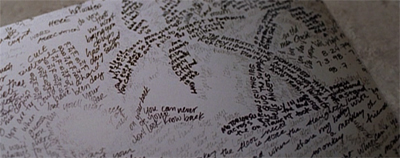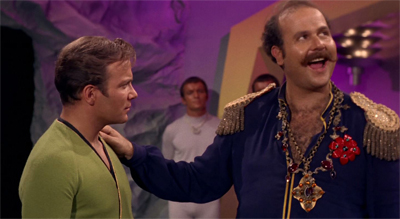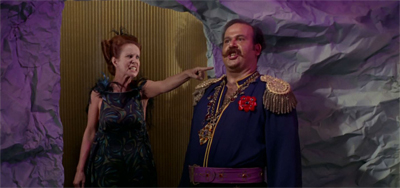There is something almost obligatory about Repression, as if the production team have arrived at the point in every season where they are obligated to do a Tuvok-centric story but without any particularly strong ideas for that Tuvok-centric story. It is there because Tim Russ is a credited lead and Tuvok is part of the ensemble, and because there is a twenty-six episode season order to fill. It is not there because any writer thought that there was a story that needed to be told with Tuvok, some part of his psyche that needed to be illuminated.
The seventh season is populated with episodes like this, stories built around particularly characters in the most archetypal of fashions. Star Trek: Voyager is frequently criticised for recycling premises from other Star Trek series, especially Star Trek: The Next Generation, but the show is less often criticised for simply repeating itself. The supporting characters on Voyager don’t really have arcs, often simply having a handful of stories that the series dutifully cycles through on rotation.

“Another fine mess(hall) you’ve gotten us into, Tuvok…”
On Star Trek: Deep Space Nine, a marathon of character-centric episodes would reveal the slow and gradual evolution of the cast. Julian Bashir changes and evolves over his time on the series, from the generic any-character-will-do narratives of The Passenger and Melora into the weirder and more awkward Distant Voices through to his emergence as a distinctive person in Hippocratic Oath, Our Man Bashir and The Quickening. Bashir is not the same character in What You Leave Behind that he was in Emissary, and watching a chain of episodes based around Bashir would explain and explore that growth.
In contrast, a character-centric marathon on Voyager would be a much more frustrating experience, as the characters inevitably go through the same motion and repeat the same plots. This is particularly true in the seventh season episodes, where the obligatory character-focused episodes underscore how little these characters have actually and fundamentally changed since the first season. In Nightingale, Harry Kim is still insecure and lacking in experience. In Lineage and Prophecy, B’Elanna Torres is once again wrestling with her Klingon heritage. In Drive, Tom Paris is once again the careless flyboy who learns about responsibility.

“The more things don’t change…”
At the same time, Tuvok has always represented a very particular challenge for the writers, in that he doesn’t even really have an archetypal story in the same way that Torres or Kim or Paris does. Tuvok doesn’t have a “lesson” that he needs to learn over and over again, or a default factory setting that he can fall back to in order to learn that lesson. At least at the end of Extreme Risk or Juggernaut, Torres had learned that she should not let her more destructive impulses guide her actions, even if she would forget it and learn again. This allows for a character arc that can be repeated and reiterated. In contrast, Tuvok was generally well-adjusted and well-balanced.
As a result, stories featuring Tuvok tend to take something away from him and watch him struggle to return to normality. As a Vulcan, Tuvok is often stripped of his Vulcan reserve and forced to recover it. The results can be interesting and compelling, with Meld and Gravity ranking among the best episodes that Voyager ever produced. However, these episodes can also feel very trite and formulaic, often reducing Tuvok to a passenger in stories nominally focused on him: he drives a lot of the plot in Random Thoughts, but Torres in the focal character; Riddles is about something that happens to Tuvok, but focuses on Neelix.

Looking at things from a new perspective.
Repression is notably the show’s last Tuvok-centric story. It is also perhaps the most archetypal. As with episodes like Nightingale or Lineage, it is a collection of familiar tropes for a supporting cast member trotted out one last time before the show crosses the finish line. Repression is an episode that has clearly been assembled from a variety of earlier episodes focused on Tuvok, right down to plot points and individual scenes or costume choices; it is Random Thoughts meets Meld, with an extended final-act homage to Worst Case Scenario. All of which reduces Tuvok to a passenger in his own story.
This is a shame, as Repression works about as well as any episode built around its core premise has any right to it. Like Drive before it, there’s a certain pulpy thrill to its core premise that fits comfortably within the heightened retro sci-fi surroundings of Voyager. The story of a detective who is investigating himself, spreading subversive ideas through telepathic assault, Repression is a patently absurd bit of television which feels very much of a piece with earlier stories like Cathexis or Macrocosm or Darkling or In the Flesh. It works much better as a trashy late-night B-movie than as a character-centric narrative.

There’ll be Meld to pay for this.
Continue reading →
Filed under: Voyager | Tagged: Emotion, logic, obama, race, recycled, restraint, star trek, star trek: voyager, the manchurian candidate, the maquis, tuvok, Vulcans | 5 Comments »




































